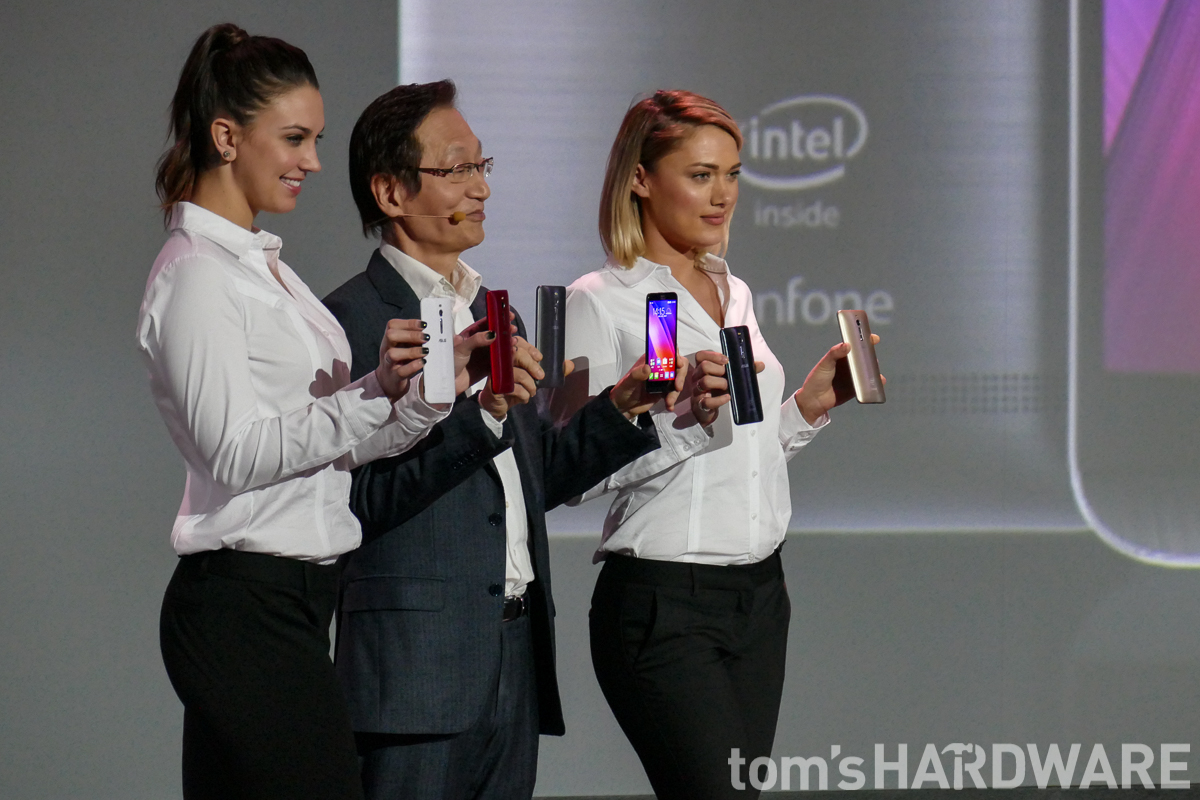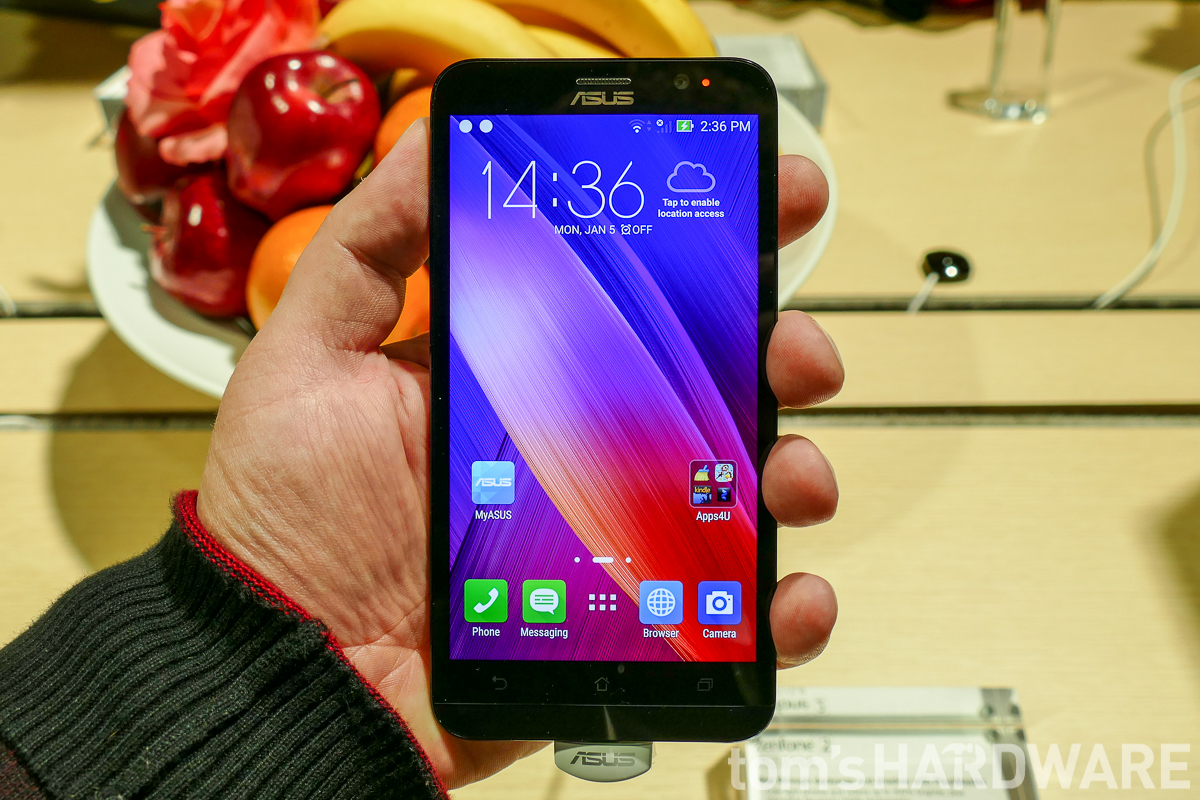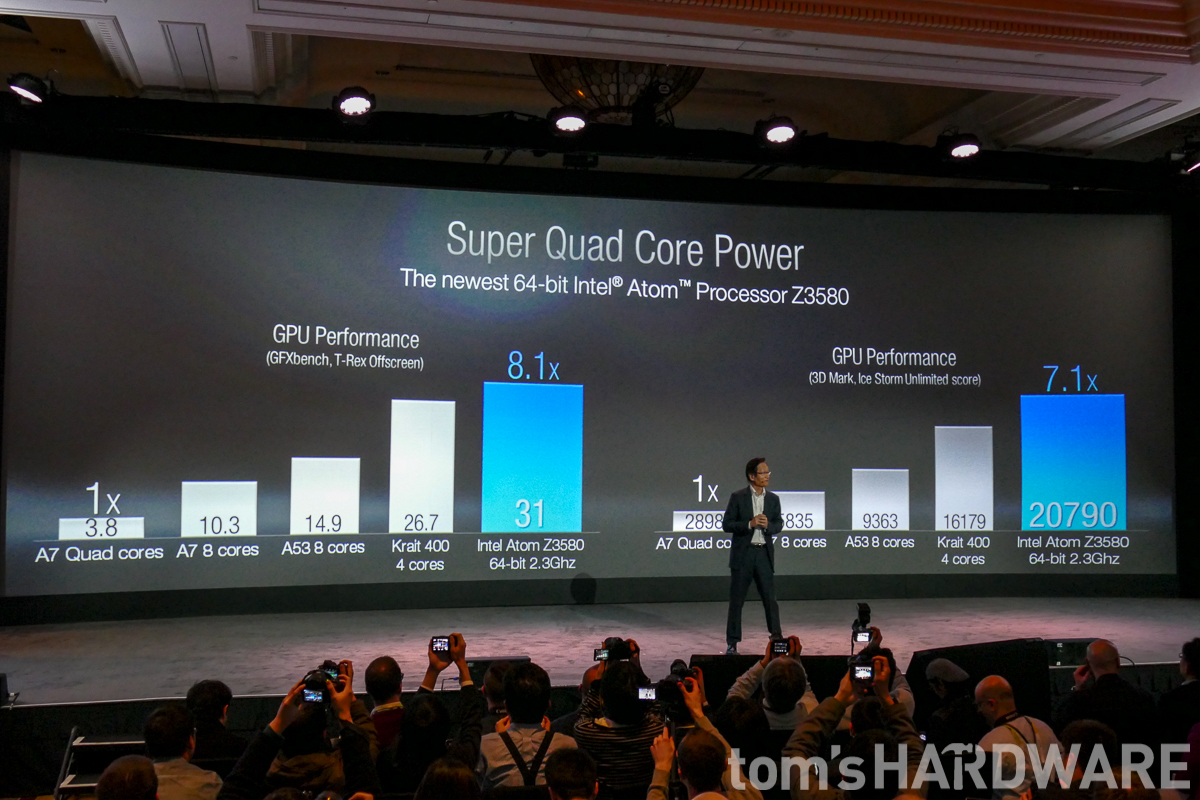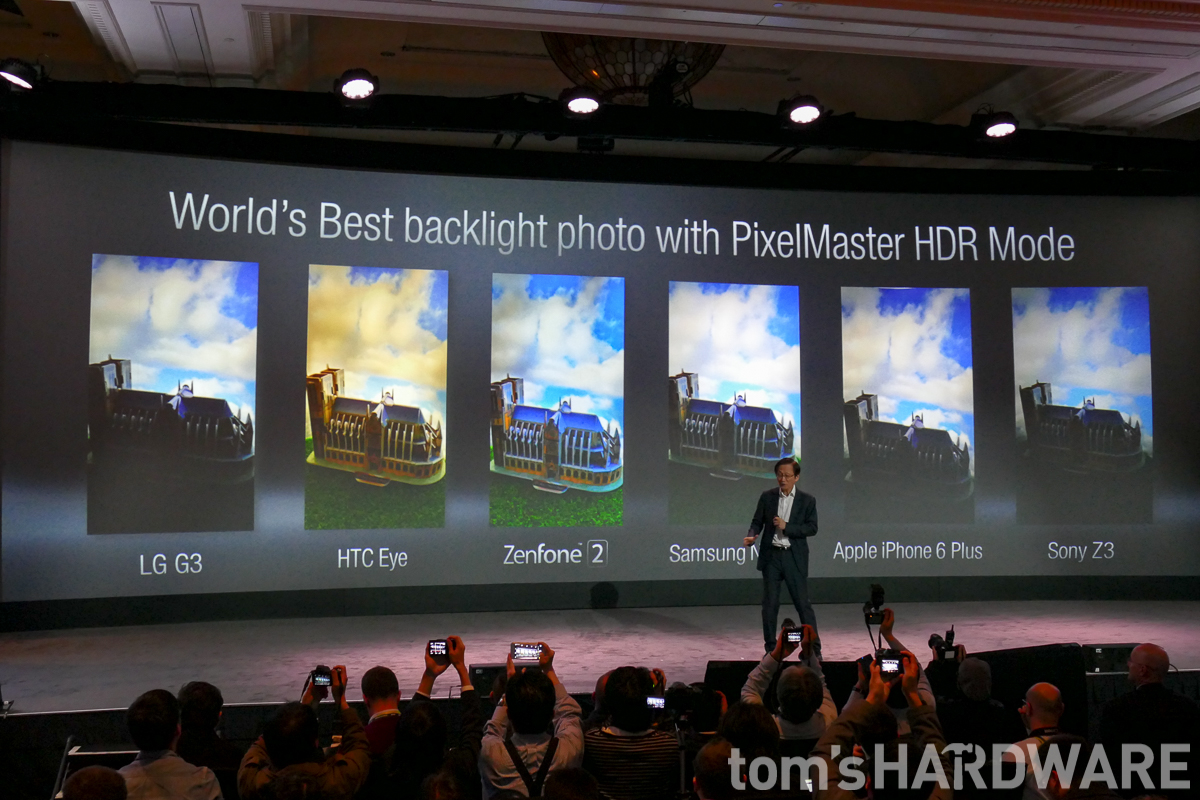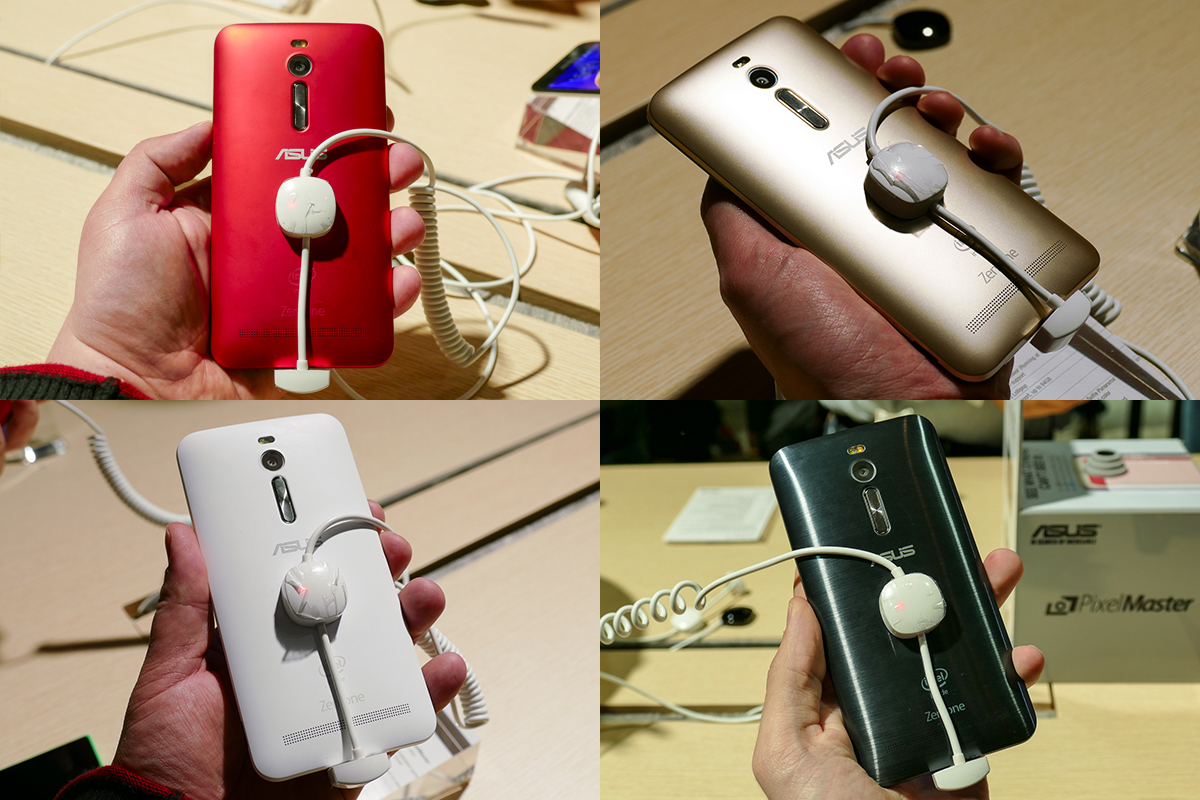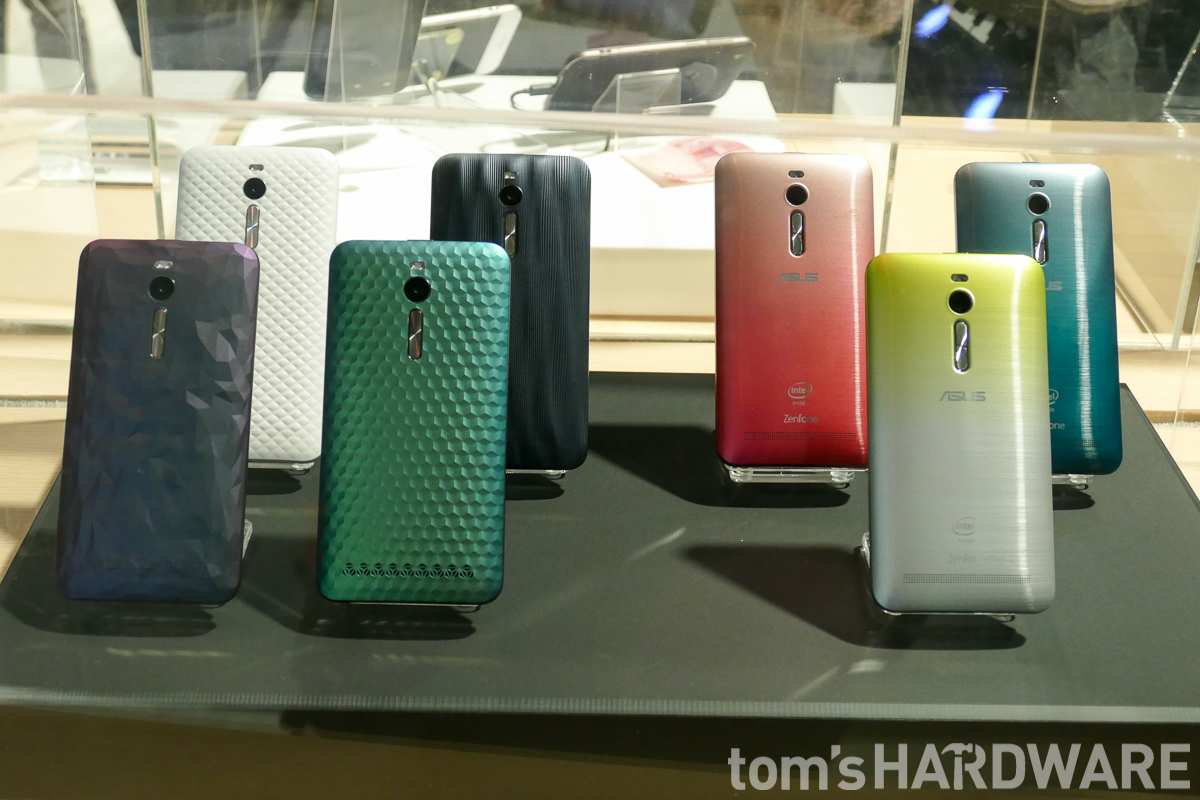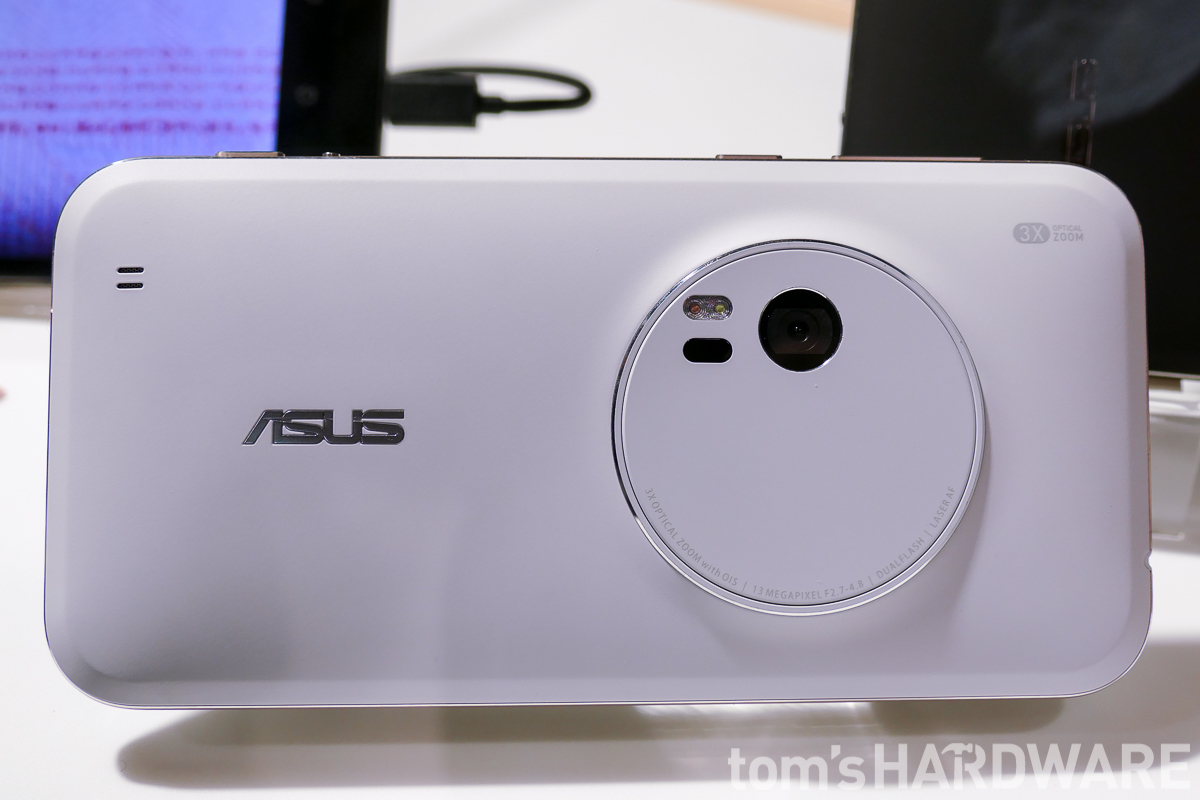Asus Refreshes Smartphone Lineup With Two New ZenFone Devices
Last year, Asus introduced a complete range of ZenFone Intel-powered smartphones with screen sizes ranging from 4- to 6-inches at CES 2014. For CES 2015, the company refreshes the ZenFone line with two new models, both with the sweet-spot screen size of 5.5-inches.
ZenFone 2
The ZenFone 2 is an Intel-powered smartphone that is fairly compact despite its big screen. The base model uses a 64-bit Intel Atom Z3560 "Moorefield" SoC running at 1.8 GHz, paired with 2 GB of RAM and 16 GB of internal storage. The higher priced model comes with a 64-bit Atom Z3580 SoC at 2.33 GHz and will be one of the first phones with a generous 4 GB of RAM.
Tech Specs
| SoC | 64-bit Quad Core Intel Atom Z3560 @ 1.8 GHz or Z3580 @ 2.3 GHz |
|---|---|
| GPU | PowerVR G6430 @ 533 MHz |
| Memory | 2 GB or 4 GB LPDDR3 |
| Display | 5.5-inch IPS @ 1920 x 1080 (403 ppi) |
| Storage | 16 GB/32 GB/64 GB, microSD |
| Battery | 3,000 mAh with fast-charge technology |
| Cameras | Front: 5MP, f/2.0, 85-degree wide angleRear: 13MP, f/2.0, 5-element lens, AF, dual-color 'Real Tone' flash |
| Connectivity | Wi-Fi 802.11a/b/g/n/ac, Wi-Fi Direct, Bluetooth 4.0, NFC, microUSB 2.0Cat 4 LTE Bands 1/2/3/4/5/7/8/9/17/18/19/20/28/29/38/39/40/41 (varies by region) |
| Dimensions | 152.5 x 77.2 x (10.9 - 3.9) mm |
| Weight | 170 g |
| Operating System | Android 5.0 Lollipop w/ASUS ZenUI |
| Price | Starting at $200 |
The ZenFone is a big device, approaching phablet territory, but its bezels are reasonably slim (it has a 72 percent screen-to-body ratio) so it isn't too unwieldy. It's an all-plastic device, but the faux-metallic finish on the back is still somewhat attractive. Like LG, Asus moves the volume controls to the back of the phone below the camera. The power button is at the top of the phone, making it difficult to reach, however.
On stage, Asus praised the performance of the Intel Atom Z3580 SoC that powers the ZenFone 2, claiming that it outperforms competing SoCs from Qualcomm and Apple (presumably the Snapdragon 801 and A7). We haven't seen many Atom powered phones or been able to benchmark any ourselves, so we can't corroborate Asus' claims or speak to the power efficiency of the ZenFone 2.
The ZenFone 2 uses a 13MP rear camera with f/2.0 aperture and 5-element lens (likely a Sony Exmor IMX135 or 214). While the camera does not include OIS or advanced autofocus features like laser or PDAF, Asus claims the ZenFone 2 has the best HDR mode of any camera. The included PixelMaster software also includes a low-light mode that merges pixels to create brighter images in low-light conditions.
The ZenPhone 2 uses an updated version of Asus' attractive ZenUI skin over Android 5.0 Lollipop. This update includes new gesture-based controls, a one-handed mode, and a separate work and personal profile mode they call SnapView. Another fundamental change is that all the ZenUI components are separate apps on the Google Play store, which allows Asus to roll-out updates a lot faster, the same way HTC updates Sense UI.
Get Tom's Hardware's best news and in-depth reviews, straight to your inbox.
The ZenFone 2 is available in five standard colors, including Glamour Red, Sheer Gold, Osmium Black, Ceramic White and Glacier Gray (shown in the hands-on video above). There are also going to be seven other unique (and probably more expensive) ZenFone 2 styles available in what Asus is calling the 'Transfusion' and 'Illusion' series, shown below.
It's interesting to note that $200 only buys you the lower-end ZenFone 2 with 2 GB of RAM and a slower 1.83 GHz SoC. Asus did not provide pricing for the 2.3 GHz Z3580 model with 4 GB of RAM. Depending on the markup, the faster ZenFone 2 could be a good bargain for the features and performance it offers.
It will be available in the U.S. in Q2 and will be sold unlocked; however, Asus was unable to provide any other availability details, such as where or who you will be able to buy it from.
ZenFone Zoom
Like the ZenFone 2, the ZenFone Zoom is also based around a 5.5-inch IPS display. Its differentiating feature is a 13MP camera with 3x optical zoom (12x including software interpolation) and a 10-element lens with an f/2.7 - f/4.8 aperture. It also adds OIS and a laser autofocus like that used in LG's flagship phones. Using the optical zoom capability together with the Macro camera mode lets you shoot as close as 5 cm with full manual camera controls.
Tech Specs
| SoC | Not specified |
|---|---|
| Memory | Not specified |
| Display | 5.5-inch IPS @ 1920 x 1080 (403 ppi) |
| Storage | up to 128 GB, microSD |
| Battery | 3,000 mAh with fast-charge technology |
| Cameras | Front: 5MP, f/2.0, 88-degree wide angleRear: 13MP, f/2.7 - f/4.8, 10-element lens, 3x optical zoom, OIS, laser AF, dual-color 'Real Tone' flash |
| Connectivity | Wi-Fi 802.11a/b/g/n/ac, Wi-Fi Direct, Bluetooth 4.0, microUSB 2.0Cat 4 LTE Bands 1/2/3/4/5/7/8/9/17/18/19/20/28/29/38/39/40/41 (varies by region) |
| Dimensions | 158.90 x 78.84 x 11.95 mm |
| Weight | 185 g |
| Operating System | Android 5.0 Lollipop w/ASUS ZenUI |
| Price | $400 |
The ZenFone Zoom doesn't appear to be as far along in development since Asus didn't disclose the SoC or amount of RAM. It was also only on display under glass and there weren't any demo units available.
The ZenFone Zoom comes in either Meteorite Black or Glacier White. It will be available in Q2 for $400, but Asus made no mention of North American availability.
Follow Alex Davies @alexbdavies. Follow us @tomshardware, on Facebook and on Google+.
-
DookieDraws Damn the phones! I'd rather have those 2 fine sweetie pies in the first image! Sweet baby Jesus they're fine! :PReply
Also, before I clicked the image to make it larger, I actually thought that dude had a huge mole near his mouth! Thank God it's only a microphone!
Good job capturing that first image, Tom's! -
jasonelmore When they say A7, they are not talking about Apple A7 silly toms.. They are talking about the ARM A7. There was no quad core a7 apple chipReply -
MobileEditor ReplyWhen they say A7, they are not talking about Apple A7 silly toms.. They are talking about the ARM A7. There was no quad core a7 apple chip
You are right that the slide shown on stage in this article is referencing the ARM A7 CPU. When we were talking about Intel's claim that Atom outperforms "Snapdragon 801 and A7", we were referencing data provided by Intel in a previous presentation about Merrifield that did mean the Apple A7. This was data provided by Intel for select benchmarks only though.
- Matt H. -
icemunk 2015 will be the year Intel SOCs take a big chunk of the mobile market - tablets and phones included.Reply -
dark_lord69 Replybut it still came with crappy atom
Crappy compared to full computers but awesome compared to other phones and tablets!
-
army_ant7 4GB and an Atom SoC?! They might as well put Windows 8.1 on that thang! (JK due to usability reasons of course.) Maybe they're setting up for the supposedly upcoming Windows OS on phones--not Windows Phone but actually Windows?Reply
